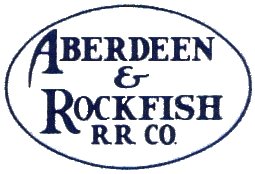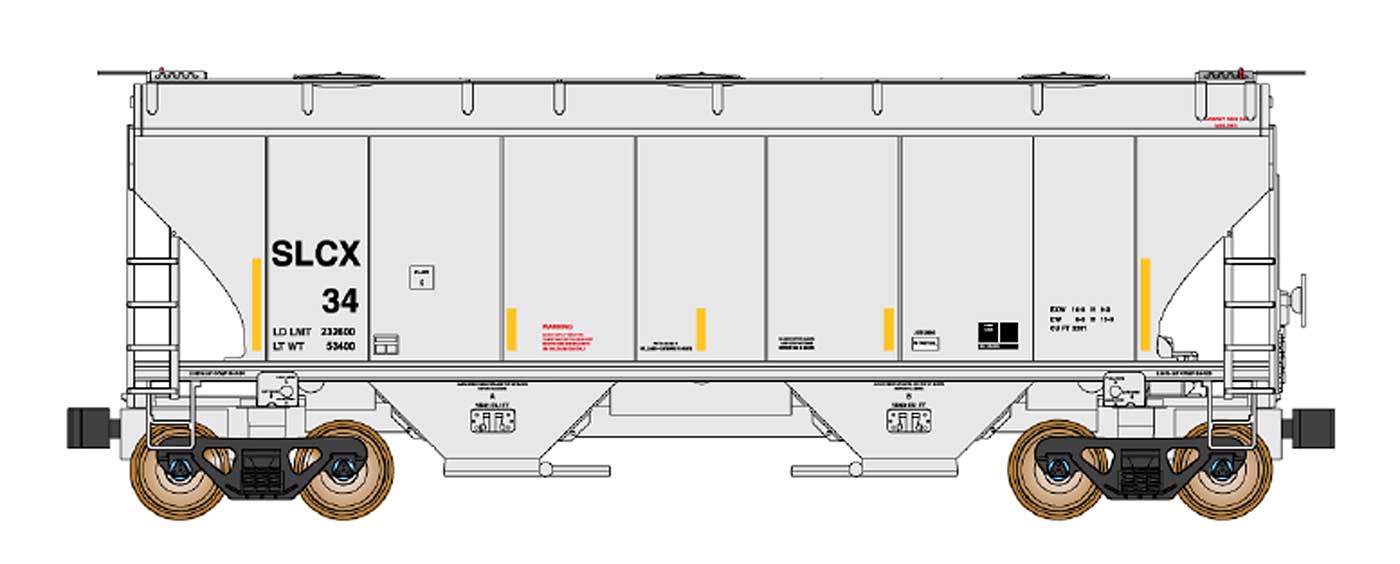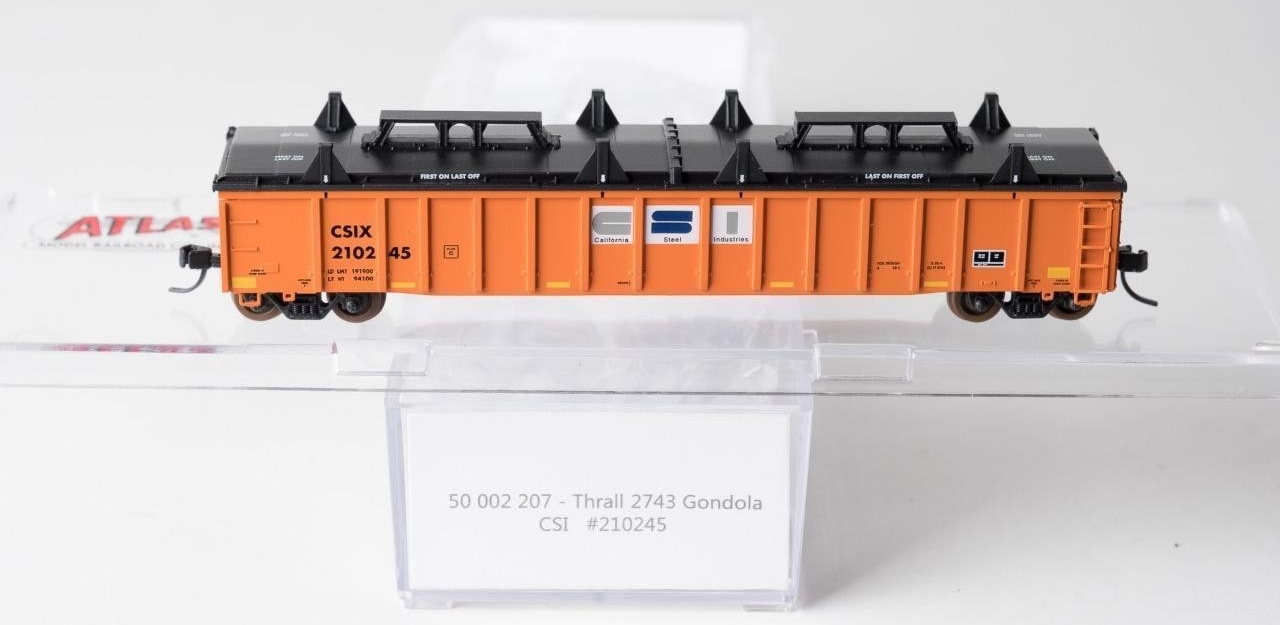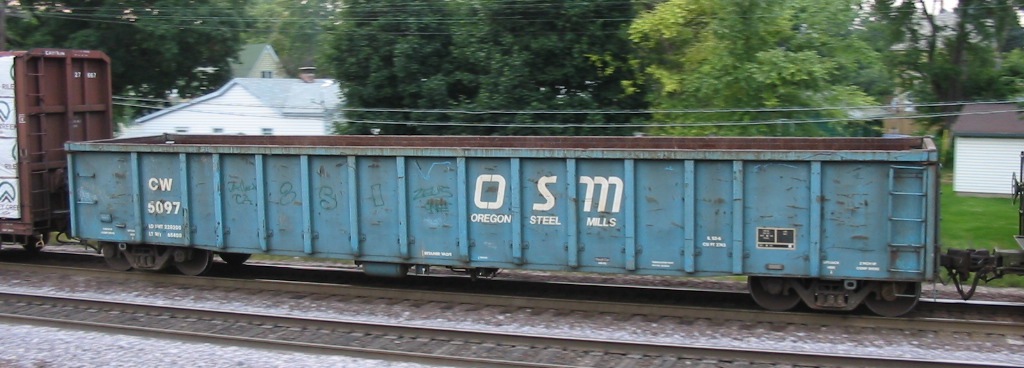Prototype History: In US railroad terminology, a gondola is an open-topped rail vehicle used for transporting loose bulk materials. Because of their low side walls gondolas are also suitable for the carriage of such high-density cargoes as steel plates or coils, or of bulky items such as prefabricated sections of rail track. For weather-sensitive loads, these gondolas are sometimes equipped with covers.
All-steel gondolas date back to the early part of the 20th century. However, most of the early ones were shorter, 40' designs. The ubiquitous 50' steel gondola we see modeled so often today is more along the lines of gondolas produced following the second world war when steel became once again readily available. Generally, they had a capacity of 70 tons and were 52'6" long. The first models of this design were produced by the Erie Railroad and the Greenville Steel Car Co, but nearly identical cars were produced by Pullman, ACF and Bethlehem.
All-steel gondolas date back to the early part of the 20th century. However, most of the early ones were shorter, 40' designs. The ubiquitous 50' steel gondola we see modeled so often today is more along the lines of gondolas produced following the second world war when steel became once again readily available. Generally, they had a capacity of 70 tons and were 52'6" long. The first models of this design were produced by the Erie Railroad and the Greenville Steel Car Co, but nearly identical cars were produced by Pullman, ACF and Bethlehem.
Road Name History:  This venerable 47 mile line in North Carolina has been around since 1892. It was founded by the Blue family who were seeking rail service for their timber interests. 126 years later and the Blue family still own it. They also own the nearby Pee Dee River Railway and the Dunn-Erwin Railway (prior to its closure.)
This venerable 47 mile line in North Carolina has been around since 1892. It was founded by the Blue family who were seeking rail service for their timber interests. 126 years later and the Blue family still own it. They also own the nearby Pee Dee River Railway and the Dunn-Erwin Railway (prior to its closure.)
The A&R runs from Fayetteville southwest to Rockfish and Dundarrach before swinging northwest toward Aberdeen. This area is just south of Fort Bragg Military Reservation. Connections on the west end are with the original Norfolk Southern and Seaboard Air Line (now CSX) and on the east end with the old Atlantic Coast Line (now CSX) and NS again. A&R also connects with shortlines Laurinburg & Southern and Cape Fear Railways. Traffic over the years has included pulpwood, sand, fertilizer, textiles, meat, oil, cement, and feed. One of the old local landmarks was a tuberculosis hospital that received coal for heating via the A&R. They run the line with a half dozen various EMD road switchers. The classy paint scheme for their diesels was introduced with their first diesel, a new EMD F3A, in 1947 and has been used ever since.

The A&R runs from Fayetteville southwest to Rockfish and Dundarrach before swinging northwest toward Aberdeen. This area is just south of Fort Bragg Military Reservation. Connections on the west end are with the original Norfolk Southern and Seaboard Air Line (now CSX) and on the east end with the old Atlantic Coast Line (now CSX) and NS again. A&R also connects with shortlines Laurinburg & Southern and Cape Fear Railways. Traffic over the years has included pulpwood, sand, fertilizer, textiles, meat, oil, cement, and feed. One of the old local landmarks was a tuberculosis hospital that received coal for heating via the A&R. They run the line with a half dozen various EMD road switchers. The classy paint scheme for their diesels was introduced with their first diesel, a new EMD F3A, in 1947 and has been used ever since.
Brand/Importer Information: In 1924 Stephan Schaffan, Sr. founded the Atlas Tool Company in Newark, New Jersey. In 1933 his son, Stephan Schaffan, Jr., came to work for his father at the age of sixteen. Steve Jr. built model airplanes as a hobby and frequented a local hobby shop. Being an enterprising young man, he would often ask the owner if there was anything he could do to earn some extra spending money. Tired of listening to his requests, the hobby-store owner threw some model railroad track parts his way and said, "Here, see if you can improve on this".
In those days, railroad modelers had to assemble and build everything from scratch. Steve Jr. created a "switch kit" which sold so well, that the entire family worked on them in the basement at night, while doing business as usual in the machine shop during the day.
Subsequently, Steve Jr. engineered the stapling of rail to fiber track, along with inventing the first practical rail joiner and pre-assembled turnouts and flexible track. All of these products, and more, helped to popularize model railroading and assisted in the creation of a mass-market hobby. The budding entrepreneur quickly outgrew the limitations of a basement and small garage operation. Realizing they could actually make a living selling track and related products, Steve and his father had the first factory built in Hillside, New Jersey at 413 Florence Avenue in 1947. On September 30, 1949, the Atlas Tool Company was officially incorporated as a New Jersey company.
In 1985, Steve was honored posthumously for his inventions by the Model Railroad Industry Association and was inducted into the Model Railroad Industry Hall of Fame in Baltimore, Maryland. In addition, Steve was nominated and entered into the National Model Railroad Association Pioneers of Model Railroading in 1995.
In the early 1990s, the Atlas Tool Company changed its name to Atlas Model Railroad Company, Inc.
In those days, railroad modelers had to assemble and build everything from scratch. Steve Jr. created a "switch kit" which sold so well, that the entire family worked on them in the basement at night, while doing business as usual in the machine shop during the day.
Subsequently, Steve Jr. engineered the stapling of rail to fiber track, along with inventing the first practical rail joiner and pre-assembled turnouts and flexible track. All of these products, and more, helped to popularize model railroading and assisted in the creation of a mass-market hobby. The budding entrepreneur quickly outgrew the limitations of a basement and small garage operation. Realizing they could actually make a living selling track and related products, Steve and his father had the first factory built in Hillside, New Jersey at 413 Florence Avenue in 1947. On September 30, 1949, the Atlas Tool Company was officially incorporated as a New Jersey company.
In 1985, Steve was honored posthumously for his inventions by the Model Railroad Industry Association and was inducted into the Model Railroad Industry Hall of Fame in Baltimore, Maryland. In addition, Steve was nominated and entered into the National Model Railroad Association Pioneers of Model Railroading in 1995.
In the early 1990s, the Atlas Tool Company changed its name to Atlas Model Railroad Company, Inc.
Item created by: Bryan on 2016-08-22 13:22:32. Last edited by gdm on 2018-11-09 13:23:46
If you see errors or missing data in this entry, please feel free to log in and edit it. Anyone with a Gmail account can log in instantly.
If you see errors or missing data in this entry, please feel free to log in and edit it. Anyone with a Gmail account can log in instantly.










